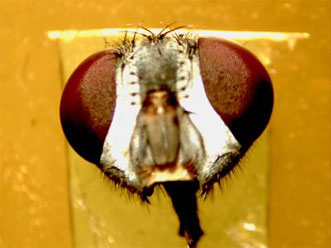
Bug Eyes Inspire Practical Light, Sensor Designs
UNIVERSITY PARK, Pa., Sept. 11, 2014 — The compound structure of a fly’s eye could become a blueprint for future sensors and light sources.
A team from Pennsylvania State University is studying and using this structure — a hexagonal, convex pattern consisting of hundreds of ommatidia that produce a nearly 360° field of vision — to develop miniature, omnidirectional light-emitting devices and optical sensors.
That wide field of view makes insect eyes “attractive for bioreplication as artificial sources of light,” the researchers wrote in a study.
“We said, OK, we can make something artificial using the same replicating structure to emit light in all directions, rather than what we have now, which is just planar, light-emitting diodes,” said Dr. Raul J. Martin-Palma, an adjunct professor of materials science and engineering at Penn State.

The compound structure of common blowfly eyes could serve as the basis for future light-emitting devices and optical sensors. Courtesy of D.P. Pulsifer/Pennsylvania State University.
The researchers extracted the corneas of common blowflies and coated them with a 900-nm-thick layer of a tris(8-hydroxyquinolinato) aluminum, a fluorescent polymer, to determine the structures' light-scattering properties. The modified surface was illuminated by shortwave UV light, prompting it to emit visible light.
“By coating the eyes, we were able to have a better light emission, or a better angular distribution of light emission,” Martin-Palma said.
When compared to a similarly coated flat surface, the researchers said the modified ommatidia scattered light more uniformly in all directions. Fly corneas could be adapted to extremely small light-emitting diodes and detectors that would be able to process light output and input from a very wide field of vision, according to the researchers.
They next plan to expand the coating procedure to include other species’ compound eyes; this could allow identification of the optimal structure for omnidirectional light emission.
The researchers will also look further into fabricating a light-emitting diode in the shape of a compound eye, which could facilitate omnidirectional light detectors.
The research was published in Applied Physics Letters (doi: 10.1063/1.4895114).
For more information, visit www.psu.edu.
Published: September 2014